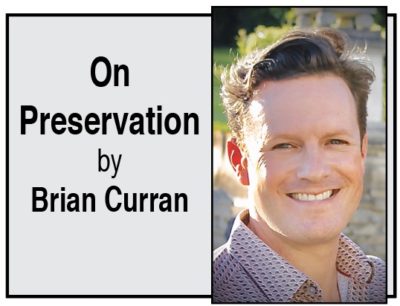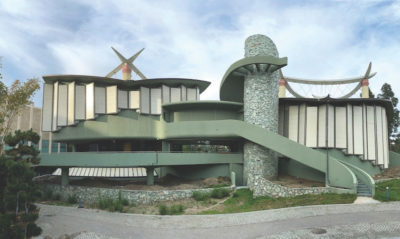On Preservation: Preservation anchors construction at La Brea Tar Pits, Academy, LACMA
 With the announcement of Weiss / Manfredi as chief architects of the reimagining of the La Brea Tar Pits Museum, a clear and welcome pattern has emerged. In each step of the re-design, expansion and rejuvenation of Hancock Park’s collection of three major museums, preservation of a significant historic structure is a key element.
With the announcement of Weiss / Manfredi as chief architects of the reimagining of the La Brea Tar Pits Museum, a clear and welcome pattern has emerged. In each step of the re-design, expansion and rejuvenation of Hancock Park’s collection of three major museums, preservation of a significant historic structure is a key element.
Entitled “La Brea Loops and Lenses: A Journey Through Multiple Epochs,” the dynamic concept from the Weiss / Manfredi firm was the only proposal (of three presented) that preserves Willis Fagan and Thomas Thornton’s original 1977 “Brutalist and Organic Modern” George C. Page building. (Read the Los Angeles Conservancy description: tinyurl.com/sb3dbyj.)
The historic Page Museum structure not only informs the design of the museum’s new wing, which also rises above as well as sits below the undulating landscape, it also serves as the linchpin for a constellation of new museum buildings, exhibition spaces, excavation pits, gardens and lawns. In this way, the new design is connected to the Tar Pits’ architectural past, providing continuity and preserving memory.
Academy Museum
A similar dynamic is at play at the nearby Academy Museum of Motion Pictures located at the other end of the park. Here, architects Renzo Piano and Gensler embraced the Streamline Moderne former May Company building that Albert C. Martin Sr. designed in 1939, the year considered the apex of Hollywood’s Golden Age when the “Wizard of Oz” and “Gone With the Wind” were released.
With completion of the building’s extraordinary restoration, led by preservation architect John Fidler, and the near-completion of Piano’s futurist floating sphere, it now is clear that the architects have achieved what before seemed inconceivable, an architectural complementarity which celebrates the past while leaping into the future.
County Art Museum

PAVILION for Japanese Art at LACMA, designed by Bruce Goff in 1988, will remain as a part of the museum campus.
However, it is at the Los Angeles County Museum of Art, LACMA — where the museum’s current leaders intend to raze portions of the existing museum to replace them with Peter Zumthor’s amorphous and audacious design — that there has been the most controversy involving art and architecture critics and preservationists alike.
For today’s visitors to LACMA, it is difficult to imagine William Pereira’s original and elegant stripped-down modernist LACMA acropolis, which debuted on Wilshire Boulevard in 1965. Within a decade, the fountains and reflecting pools were gone. Then, in 1986, Hardy Holzman Pfeiffer’s grandiose post-modern facelift, with its new galleries and Babylonian gateway, all but erased Pereira’s vision.
Resistance to Zumthor’s plan includes opposition to the project’s expense and alleged reduction in museum gallery space, while hesitant preservationists have advocated for the reuse of Pereira’s original buildings regardless of their condition. Part of this reuse advocacy is due to some of those same preservationists having fought losing battles to save other parts of the architect’s Los Angeles legacy — the planned demolition of Pereira’s Times-Mirror Square addition, as well as the plans for partial demolition and alteration of the former Metropolitan Water District Headquarters on Sunset Boulevard.
But even with the loss of LACMA’s original Pereira structures, the Zumthor plans do call for the preservation of Bruce Goff’s ethereal swan song, the 1988 Pavilion for Japanese Art, which will remain as the idiosyncratic echo of what had been. There was a time in the city’s history when that building, too, would go — a time when the bulldozers would have created a clean slate where a new generation could construct its architectural ambitions without being hindered by the works of predecessors.
Such was the case in 1965 when Henry Hancock’s ranch house was bulldozed for the new LACMA. Today, Hancock Park and its La Brea Tar Pits, according to Christopher Hawthorne, chief design officer for the City of Los Angeles, is a “place of deep emotional connection and nostalgia for Angelenos.” So it is heartening that, in the often fraught and herculean efforts to upgrade the park’s museums and facilities, today’s planners, architects and the public have recognized the value of its historic structures and ensured their preservation and inclusion in the future of the park.
Category: Real Estate
